Environmental DNA Reveals the Impact of Submarine Groundwater Discharge on the Spatial Variability of Coastal Fish Diversity
Abstract
:Simple Summary
Abstract
1. Introduction
2. Materials and Methods
2.1. Study Area Information
2.2. Sampling Collection
2.3. Environmental DNA Analysis, Taxonomic Verification
2.4. Functional Traits Verification
2.5. Evaluation of Spatial Variability of SGD
2.6. Data Analysis and Statistics
3. Results
3.1. Spatial Variability of Fish Communities
3.2. Impacts of SGD on Fish Diversities
4. Discussion
5. Conclusions
Supplementary Materials
Author Contributions
Funding
Institutional Review Board Statement
Informed Consent Statement
Data Availability Statement
Acknowledgments
Conflicts of Interest
References
- Fabricius, K.E. Effects of Terrestrial Runoff on the Ecology of Corals and Coral Reefs: Review and Synthesis. Mar. Pollut. Bull. 2005, 50, 125–146. [Google Scholar] [CrossRef]
- Kuang, T.; Chen, W.; Huang, S.; Liu, L.; Zhou, L. Environmental Drivers of the Functional Structure of Fish Communities in the Pearl River Estuary. Estuar. Coast. Shelf Sci. 2021, 263, 107625. [Google Scholar] [CrossRef]
- Encarnação, J.; Leitão, F.; Range, P.; Piló, D.; Chícharo, M.A.; Chícharo, L. Local and Temporal Variations in Near-Shore Macrobenthic Communities Associated with Submarine Groundwater Discharges. Mar. Ecol. 2015, 36, 926–941. [Google Scholar] [CrossRef]
- Vinagre, C.; Máguas, C.; Cabral, H.N.; Costa, M.J. Spatial Variation in River Runoff into a Coastal Area—An Ecological Approach. J. Sea Res. 2011, 65, 362–367. [Google Scholar] [CrossRef]
- Moosdorf, N.; Oehler, T. Societal Use of Fresh Submarine Groundwater Discharge: An Overlooked Water Resource. Earth Sci. Rev. 2017, 171, 338–348. [Google Scholar] [CrossRef]
- La Valle, F.F.; Kantar, M.B.; Nelson, C.E. Coral Reef Benthic Community Structure Is Associated with the Spatiotemporal Dynamics of Submarine Groundwater Discharge Chemistry. Limnol. Oceanogr. 2021, 66, 188–200. [Google Scholar] [CrossRef]
- Getz, E.; Eckert, C. Effects of Salinity on Species Richness and Community Composition in a Hypersaline Estuary. Estuaries Coasts 2023, 46, 2175–2189. [Google Scholar] [CrossRef]
- Fujita, K.; Shoji, J.; Sugimoto, R.; Nakajima, T.; Honda, H.; Takeuchi, M.; Tominaga, O.; Taniguchi, M. Increase in Fish Production through Bottom-Up Trophic Linkage in Coastal Waters Induced by Nutrients Supplied via Submarine Groundwater. Front. Environ. Sci. 2019, 7, 82. [Google Scholar] [CrossRef]
- Lilkendey, J.; Pisternick, T.; Neumann, S.I.; Dumur Neelayya, D.; Bröhl, S.; Neehaul, Y.; Moosdorf, N. Fresh Submarine Groundwater Discharge Augments Growth in a Reef Fish. Front. Mar. Sci. 2019, 6, 613. [Google Scholar] [CrossRef]
- Ruppert, K.M.; Kline, R.J.; Rahman, M.S. Past, Present, and Future Perspectives of Environmental DNA (EDNA) Metabarcoding: A Systematic Review in Methods, Monitoring, and Applications of Global EDNA. Glob. Ecol. Conserv. 2019, 17, e00547. [Google Scholar] [CrossRef]
- Nguyen, B.N.; Shen, E.W.; Seemann, J.; Correa, A.M.S.; O’Donnell, J.L.; Altieri, A.H.; Knowlton, N.; Crandall, K.A.; Egan, S.P.; McMillan, W.O.; et al. Environmental DNA Survey Captures Patterns of Fish and Invertebrate Diversity across a Tropical Seascape. Sci. Rep. 2020, 10, 6729. [Google Scholar] [CrossRef] [PubMed]
- Kume, M.; Lavergne, E.; Ahn, H.; Terashima, Y.; Kadowaki, K.; Ye, F.; Kameyama, S.; Kai, Y.; Henmi, Y.; Yamashita, Y.; et al. Factors Structuring Estuarine and Coastal Fish Communities across Japan Using Environmental DNA Metabarcoding. Ecol. Indic. 2021, 121, 107216. [Google Scholar] [CrossRef]
- Bleijswijk, J.D.L.; Engelmann, J.C.; Klunder, L.; Witte, H.J.; Witte, J.I.; Veer, H.W. Analysis of a Coastal North Sea Fish Community: Comparison of Aquatic Environmental DNA Concentrations to Fish Catches. Environ. DNA 2020, 2, 429–445. [Google Scholar] [CrossRef]
- McElroy, M.E.; Dressler, T.L.; Titcomb, G.C.; Wilson, E.A.; Deiner, K.; Dudley, T.L.; Eliason, E.J.; Evans, N.T.; Gaines, S.D.; Lafferty, K.D.; et al. Calibrating Environmental DNA Metabarcoding to Conventional Surveys for Measuring Fish Species Richness. Front. Ecol. Evol. 2020, 8, 276. [Google Scholar] [CrossRef]
- Lee, Y.D.; Lee, G.M.; Park, J.Y.; Gwak, W.S. Comparing Environmental DNA Metabarcoding and Underwater Visual Census to Monitor Korean Coastal Fish Community. Ocean. Sci. J. 2022, 57, 592–606. [Google Scholar] [CrossRef]
- Gösser, F.; Schweinsberg, M.; Mittelbach, P.; Schoenig, E.; Tollrian, R. An Environmental DNA Metabarcoding Approach versus a Visual Survey for Reefs of Koh Pha-ngan in Thailand. Environ. DNA 2023, 5, 297–311. [Google Scholar] [CrossRef]
- Saccò, M.; Guzik, M.T.; van der Heyde, M.; Nevill, P.; Cooper, S.J.B.; Austin, A.D.; Coates, P.J.; Allentoft, M.E.; White, N.E. eDNA in Subterranean Ecosystems: Applications, Technical Aspects, and Future Prospects. Sci. Total Environ. 2022, 820, 153223. [Google Scholar] [CrossRef] [PubMed]
- Xing, Y.; Gao, W.; Shen, Z.; Zhang, Y.; Bai, J.; Cai, X.; Ouyang, J.; Zhao, Y. A Review of Environmental DNA Field and Laboratory Protocols Applied in Fish Ecology and Environmental Health. Front. Environ. Sci. 2022, 10, 725360. [Google Scholar] [CrossRef]
- Blabolil, P.; Harper, L.R.; Říčanová, Š.; Sellers, G.; Di Muri, C.; Jůza, T.; Vašek, M.; Sajdlová, Z.; Rychtecký, P.; Znachor, P.; et al. Environmental DNA Metabarcoding Uncovers Environmental Correlates of Fish Communities in Spatially Heterogeneous Freshwater Habitats. Ecol. Indic. 2021, 126, 107698. [Google Scholar] [CrossRef]
- Zhong, W.; Zhang, J.; Wang, Z.; Lin, J.; Huang, X.; Liu, W.; Li, H.; Pellissier, L.; Zhang, X. Holistic Impact Evaluation of Human Activities on the Coastal Fish Biodiversity in the Chinese Coastal Environment. Environ. Sci. Technol. 2022, 56, 6574–6583. [Google Scholar] [CrossRef]
- Czeglédi, I.; Sály, P.; Specziár, A.; Preiszner, B.; Szalóky, Z.; Maroda, Á.; Pont, D.; Meulenbroek, P.; Valentini, A.; Erős, T. Congruency between Two Traditional and EDNA-Based Sampling Methods in Characterising Taxonomic and Trait-Based Structure of Fish Communities and Community-Environment Relationships in Lentic Environment. Ecol. Indic. 2021, 129, 107952. [Google Scholar] [CrossRef]
- Camara, E.M.; de Andrade-Tubino, M.F.; Franco, T.P.; Neves, L.M.; dos Santos, L.N.; dos Santos, A.F.G.N.; Araújo, F.G. Temporal Dimensions of Taxonomic and Functional Fish Beta Diversity: Scaling Environmental Drivers in Tropical Transitional Ecosystems. Hydrobiologia 2023, 850, 1911–1940. [Google Scholar] [CrossRef]
- Li, Y.; Wang, J.; Ju, P.; Zhang, C.; Liu, B.; Wang, Y. Different Responses of Taxonomic and Functional Diversity to Environmental Changes: Case Study of Fish Communities in the Zhoushan Fishing Ground, China. Aquat. Sci. 2023, 85, 117. [Google Scholar] [CrossRef]
- Shah Esmaeili, Y.; Corte, G.N.; Checon, H.H.; Bilatto, C.G.; Lefcheck, J.S.; Zacagnini Amaral, A.C.; Turra, A. Revealing the Drivers of Taxonomic and Functional Diversity of Nearshore Fish Assemblages: Implications for Conservation Priorities. Divers. Distrib. 2022, 28, 1597–1609. [Google Scholar] [CrossRef]
- Aglieri, G.; Baillie, C.; Mariani, S.; Cattano, C.; Calò, A.; Turco, G.; Spatafora, D.; Di Franco, A.; Di Lorenzo, M.; Guidetti, P.; et al. Environmental DNA Effectively Captures Functional Diversity of Coastal Fish Communities. Mol. Ecol. 2021, 30, 3127–3139. [Google Scholar] [CrossRef] [PubMed]
- Henriques, S.; Guilhaumon, F.; Villéger, S.; Amoroso, S.; França, S.; Pasquaud, S.; Cabral, H.N.; Vasconcelos, R.P. Biogeographical Region and Environmental Conditions Drive Functional Traits of Estuarine Fish Assemblages Worldwide. Fish Fish. 2017, 18, 752–771. [Google Scholar] [CrossRef]
- Keck, B.P.; Marion, Z.H.; Martin, D.J.; Kaufman, J.C.; Harden, C.P.; Schwartz, J.S.; Strange, R.J. Fish Functional Traits Correlated with Environmental Variables in a Temperate Biodiversity Hotspot. PLoS ONE 2014, 9, e93237. [Google Scholar] [CrossRef] [PubMed]
- Zhu, A.; Saito, M.; Onodera, S.; Shimizu, Y.; Jin, G.; Ohta, T.; Chen, J. Evaluation of the Spatial Distribution of Submarine Groundwater Discharge in a Small Island Scale Using the 222Rn Tracer Method and Comparative Modeling. Mar. Chem. 2019, 209, 25–35. [Google Scholar] [CrossRef]
- Nhat, N.H.; Saito, M.; Hamada, M.; Onodera, S. Evaluation of the Effects of Environmental Factors on Seasonal Variations in Fish Diversity on a Coastal Island in Western Japan. Environments 2024, 11, 60. [Google Scholar] [CrossRef]
- Yoneda, M.; Fujita, T.; Yamamoto, M.; Tadokoro, K.; Okazaki, Y.; Nakamura, M.; Takahashi, M.; Kono, N.; Matsubara, T.; Abo, K.; et al. Bottom-up Processes Drive Reproductive Success of Japanese Anchovy in an Oligotrophic Sea: A Case Study in the Central Seto Inland Sea, Japan. Prog. Oceanogr. 2022, 206, 102860. [Google Scholar] [CrossRef]
- Fujita, T.; Yamamoto, M.; Kono, N.; Tomiyama, T.; Sugimatsu, K.; Yoneda, M. Temporal Variations in Hatch Date and Early Survival of Japanese Anchovy (Engraulis japonicus) in Response to Environmental Factors in the Central Seto Inland Sea, Japan. Fish. Oceanogr. 2021, 30, 527–541. [Google Scholar] [CrossRef]
- The eDNA Society Environmental DNA Sampling and Experiment Manual; The eDNA Society: Otsu, Japan, 2019.
- Takai, N.; Yorozu, A.; Tanimoto, T.; Hoshika, A.; Yoshihara, K. Transport Pathways of Microphytobenthos-Originating Organic Carbon in the Food Web of an Exposed Hard Bottom Shore in the Seto Inland Sea, Japan. Mar. Ecol. Prog. Ser. 2004, 284, 97–108. [Google Scholar] [CrossRef]
- Minamoto, T.; Miya, M.; Sado, T.; Seino, S.; Doi, H.; Kondoh, M.; Nakamura, K.; Takahara, T.; Yamamoto, S.; Yamanaka, H.; et al. An Illustrated Manual for Environmental DNA Research: Water Sampling Guidelines and Experimental Protocols. Environ. DNA 2021, 3, 8–13. [Google Scholar] [CrossRef]
- Miya, M.; Sato, Y.; Fukunaga, T.; Sado, T.; Poulsen, J.Y.; Sato, K.; Minamoto, T.; Yamamoto, S.; Yamanaka, H.; Araki, H.; et al. MiFish, a Set of Universal PCR Primers for Metabarcoding Environmental DNA from Fishes: Detection of More than 230 Subtropical Marine Species. R. Soc. Open Sci. 2015, 2, 150088. [Google Scholar] [CrossRef] [PubMed]
- Zhu, T.; Sato, Y.; Sado, T.; Miya, M.; Iwasaki, W. MitoFish, MitoAnnotator, and MiFish Pipeline: Updates in 10 Years. Mol. Biol. Evol. 2023, 40, msad035. [Google Scholar] [CrossRef] [PubMed]
- Sato, Y.; Miya, M.; Fukunaga, T.; Sado, T.; Iwasaki, W. MitoFish and MiFish Pipeline: A Mitochondrial Genome Database of Fish with an Analysis Pipeline for Environmental DNA Metabarcoding. Mol. Biol. Evol. 2018, 35, 1553–1555. [Google Scholar] [CrossRef] [PubMed]
- Iwasaki, W.; Fukunaga, T.; Isagozawa, R.; Yamada, K.; Maeda, Y.; Satoh, T.P.; Sado, T.; Mabuchi, K.; Takeshima, H.; Miya, M.; et al. Mitofish and Mitoannotator: A Mitochondrial Genome Database of Fish with an Accurate and Automatic Annotation Pipeline. Mol. Biol. Evol. 2013, 30, 2531–2540. [Google Scholar] [CrossRef] [PubMed]
- Elliott, M.; Whitfield, A.K.; Potter, I.C.; Blaber, S.J.M.; Cyrus, D.P.; Nordlie, F.G.; Harrison, T.D. The Guild Approach to Categorizing Estuarine Fish Assemblages: A Global Review. Fish Fish. 2007, 8, 241–268. [Google Scholar] [CrossRef]
- Able, K.W.; Simenstad, C.A.; Strydom, N.A.; Bradley, M.; Sheaves, M. Habitat Use and Connectivity. In Fish and Fisheries in Estuaries; Wiley: Hoboken, NJ, USA, 2022; pp. 188–254. [Google Scholar]
- Hwang, D.W.; Lee, I.S.; Choi, M.; Kim, T.H. Estimating the Input of Submarine Groundwater Discharge (SGD) and SGD-Derived Nutrients in Geoje Bay, Korea Using222Rn-Si Mass Balance Model. Mar. Pollut. Bull. 2016, 110, 119–126. [Google Scholar] [CrossRef] [PubMed]
- Hwang, D.W.; Lee, Y.W.; Kim, G. Large Submarine Groundwater Discharge and Benthic Eutrophication in Bangdu Bay on Volcanic Jeju Island, Korea. Limnol. Oceanogr. 2005, 50, 1393–1403. [Google Scholar] [CrossRef]
- Street, J.H.; Knee, K.L.; Grossman, E.E.; Paytan, A. Submarine Groundwater Discharge and Nutrient Addition to the Coastal Zone and Coral Reefs of Leeward Hawai’i. Mar. Chem. 2008, 109, 355–376. [Google Scholar] [CrossRef]
- Tamborski, J.J.; Cochran, J.K.; Bokuniewicz, H.J. Submarine Groundwater Discharge Driven Nitrogen Fluxes to Long Island Sound, NY: Terrestrial vs. Marine Sources. Geochim. Cosmochim. Acta 2017, 218, 40–57. [Google Scholar] [CrossRef]
- Oehler, T.; Tamborski, J.; Rahman, S.; Moosdorf, N.; Ahrens, J.; Mori, C.; Neuholz, R.; Schnetger, B.; Beck, M. DSi as a Tracer for Submarine Groundwater Discharge. Front. Mar. Sci. 2019, 6, 563. [Google Scholar] [CrossRef]
- Hwang, D.W.; Kim, G.; Lee, Y.W.; Yang, H.S. Estimating Submarine Inputs of Groundwater and Nutrients to a Coastal Bay Using Radium Isotopes. Mar. Chem. 2005, 96, 61–71. [Google Scholar] [CrossRef]
- Magneville, C.; Loiseau, N.; Albouy, C.; Casajus, N.; Claverie, T.; Escalas, A.; Leprieur, F.; Maire, E.; Mouillot, D.; Villéger, S. MFD: An R Package to Compute and Illustrate the Multiple Facets of Functional Diversity. Ecography 2022, 2022. [Google Scholar] [CrossRef]
- Villéger, S.; Mason, N.W.H.; Mouillot, D. New Multidimensional Functional Diversity Indices for a Multifaceted Framework in Functional Ecology. Ecology 2008, 89, 2290–2301. [Google Scholar] [CrossRef] [PubMed]
- Huang, H. LinkET: Everything Is Linkable. R Package Version 0.0.3, Shenzhen, China, 2021; Volume 2. [Google Scholar]
- Zuur, A.F.; Ieno, E.N.; Elphick, C.S. A Protocol for Data Exploration to Avoid Common Statistical Problems. Methods Ecol. Evol. 2010, 1, 3–14. [Google Scholar] [CrossRef]
- Bartoń, K. MuMIn: Multi-Model Inference. In R Package Version 0.12.2; PAS: Opalenica, Poland, 2023. [Google Scholar]
- Oksanen, J.; Simpson, G.L.; Blanchet, F.G.; Kindt, R.; Legendre, P.; McGlinn, D.; Minchin, P.R.; O’Hara, R.B.; Solymos, P. Package “Vegan”: Community Ecology Package. R Package Version 2.6-7, Helsinki, Finland, 2024. [Google Scholar]
- Hata, M.; Sugimoto, R.; Hori, M.; Tomiyama, T.; Shoji, J. Occurrence, Distribution and Prey Items of Juvenile Marbled Sole Pseudopleuronectes yokohamae around a Submarine Groundwater Seepage on a Tidal Flat in Southwestern Japan. J. Sea Res. 2016, 111, 47–53. [Google Scholar] [CrossRef]
- Utsunomiya, T.; Hata, M.; Sugimoto, R.; Honda, H.; Kobayashi, S.; Miyata, Y.; Yamada, M.; Tominaga, O.; Shoji, J.; Taniguchi, M. Higher Species Richness and Abundance of Fish and Benthic Invertebrates around Submarine Groundwater Discharge in Obama Bay, Japan. J. Hydrol. Reg. Stud. 2017, 11, 139–146. [Google Scholar] [CrossRef]
- Kim, Y.; Lee, J.H.; Kang, J.J.; Lee, J.H.; Lee, H.W.; Kang, C.K.; Lee, S.H. River Discharge Effects on the Contribution of Small-Sized Phytoplankton to the Total Biochemical Composition of POM in the Gwangyang Bay, Korea. Estuar. Coast. Shelf Sci. 2019, 226, 106293. [Google Scholar] [CrossRef]
- International EMECS Center. Environmental Conservation of the Seto Inland Sea; International EMECS Center, Ed.; Kobe International EMECS Center: Kobe, Japan, 2008. [Google Scholar]
- Okaichi, T. Environmental Management of the Semi Enclosed Sea and Red Tide Problems in the Seto Inland Sea. Fish. Sci. 2002, 68, 483–488. [Google Scholar] [CrossRef] [PubMed]
- Nishijima, W.; Umehara, A.; Yamamoto, K.; Asaoka, S.; Fujii, N.; Otani, S.; Wang, F.; Okuda, T.; Nakai, S. Temporal Distribution of Primary and Secondary Production Estimated from Water Quality Data in the Seto Inland Sea, Japan. Ecol. Indic. 2021, 124, 107405. [Google Scholar] [CrossRef]
- Abo, K.; Yamamoto, T. Oligotrophication and Its Measures in the Seto Inland Sea, Japan. Bull. Jpn. Fish. Res. Educ. Agency 2019, 49, 21. [Google Scholar]
- Yamamoto, T. The Seto Inland Sea—Eutrophic or Oligotrophic? In Marine Pollution Bulletin; Elsevier Ltd.: Amsterdam, The Netherlands, 2003; Volume 47, pp. 37–42. [Google Scholar]
- Yanagi, T. Oligotrophication in the Seto Inland Sea. In Eutrophication and Oligotrophication in Japanese Estuaries; Yanagi, T., Ed.; Springer: Dordrecht, Germany, 2015; pp. 39–67. [Google Scholar]
- Tanda, M.; Harada, K. Nutrient Environment and Fisheries in the Eastern Seto Inland Sea (Harima Nada). Aquabiology 2012, 34, 132–141. [Google Scholar]
- Luo, Z.; Yang, C.; Wang, L.; Liu, Y.; Shan, B.; Liu, M.; Chen, C.; Guo, T.; Sun, D. Relationships between Fish Community Structure and Environmental Factors in the Nearshore Waters of Hainan Island, South China. Diversity 2023, 15, 901. [Google Scholar] [CrossRef]
- Cheng, X.; Wang, Z.; Zhang, S.; Zhao, X.; Lin, J.; Huang, H.; Chen, Y.; Zou, Q. Analysis of Short-Term and Local Scale Variations in Fish Community Structure in Dachen Island Waters. Front. Mar. Sci. 2023, 10, 1199524. [Google Scholar] [CrossRef]
- Snigirov, S.; Goncharov, O.; Sylantyev, S. The Fish Community in Zmiinyi Island Waters: Structure and Determinants. Mar. Biodivers. 2012, 42, 225–239. [Google Scholar] [CrossRef]
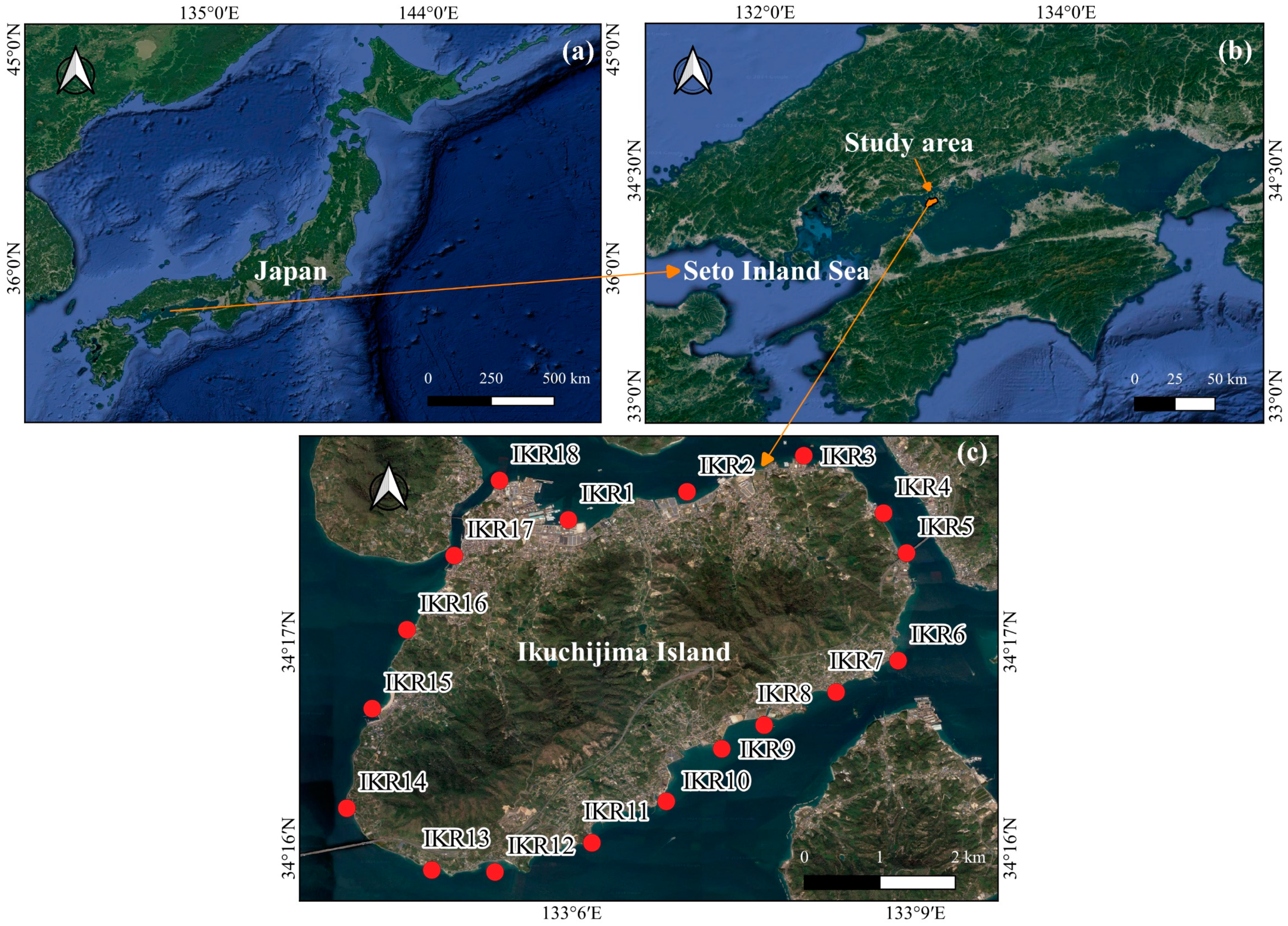
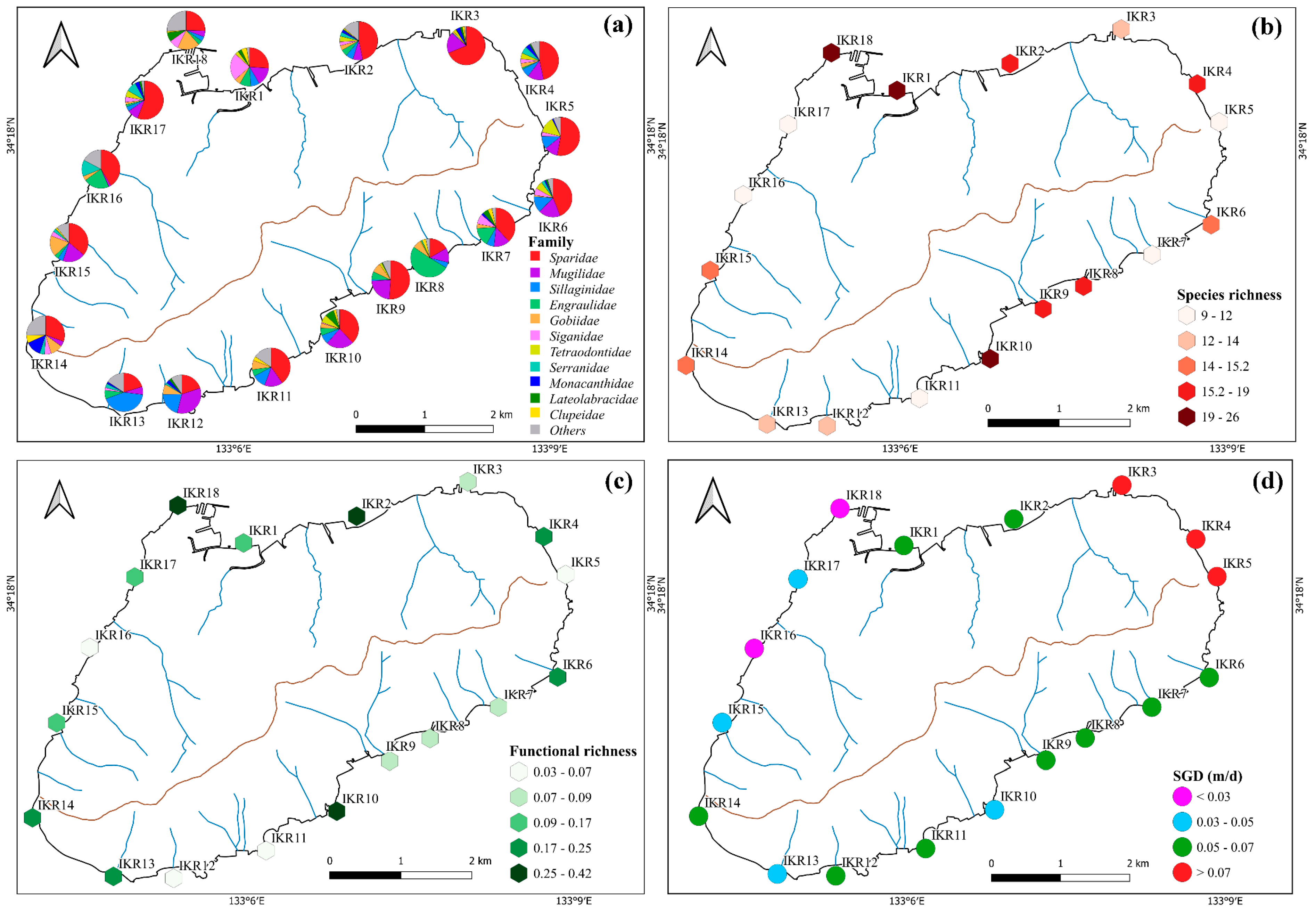
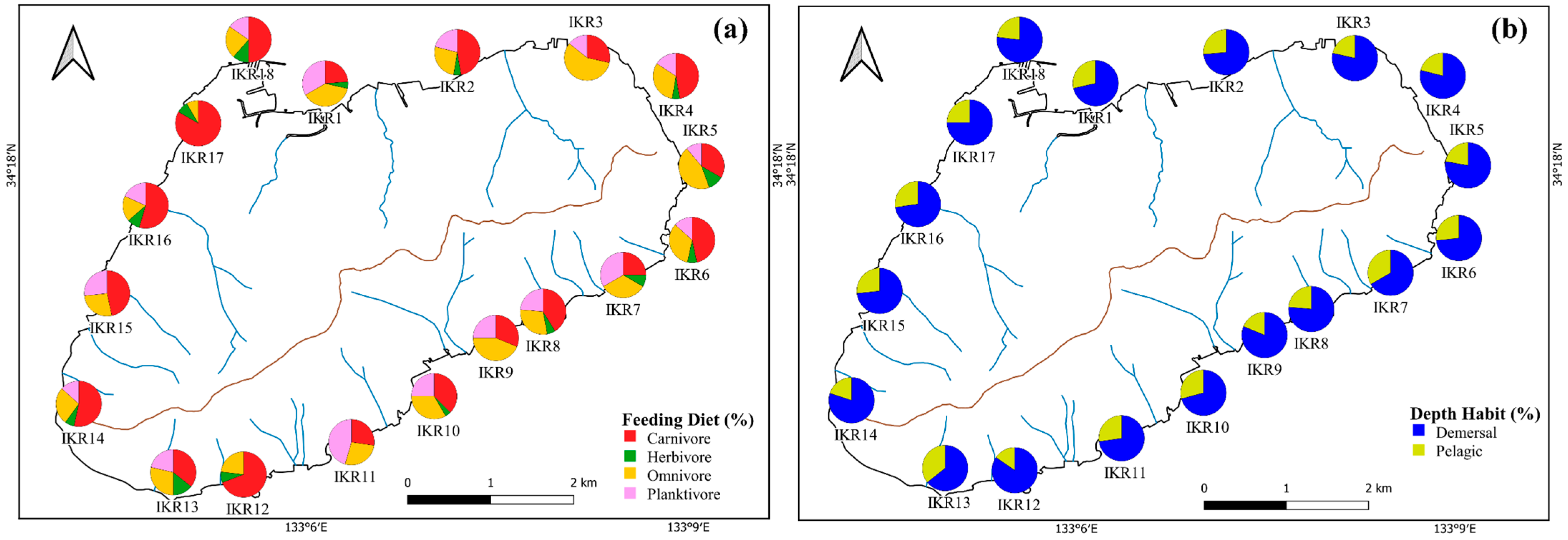
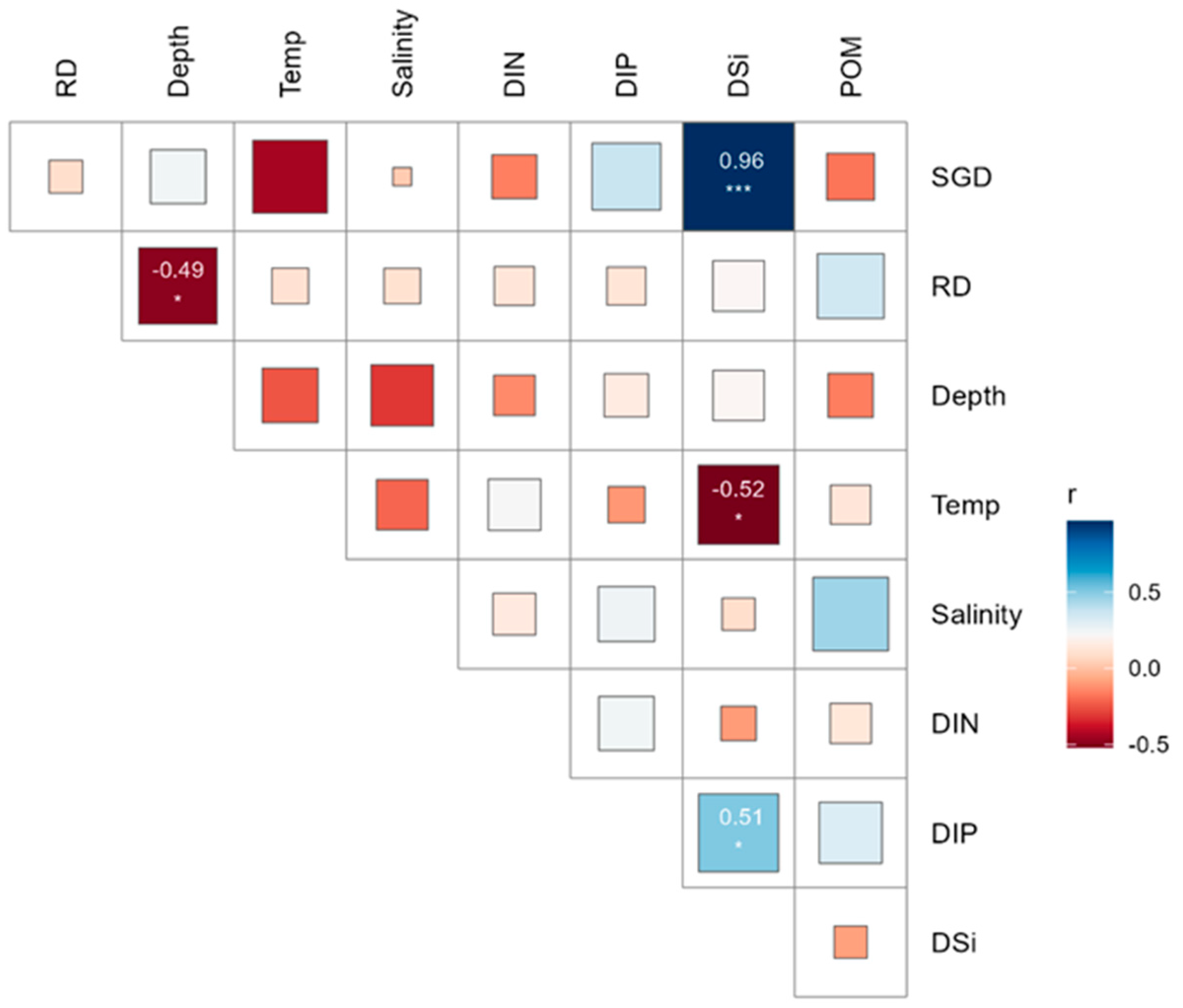
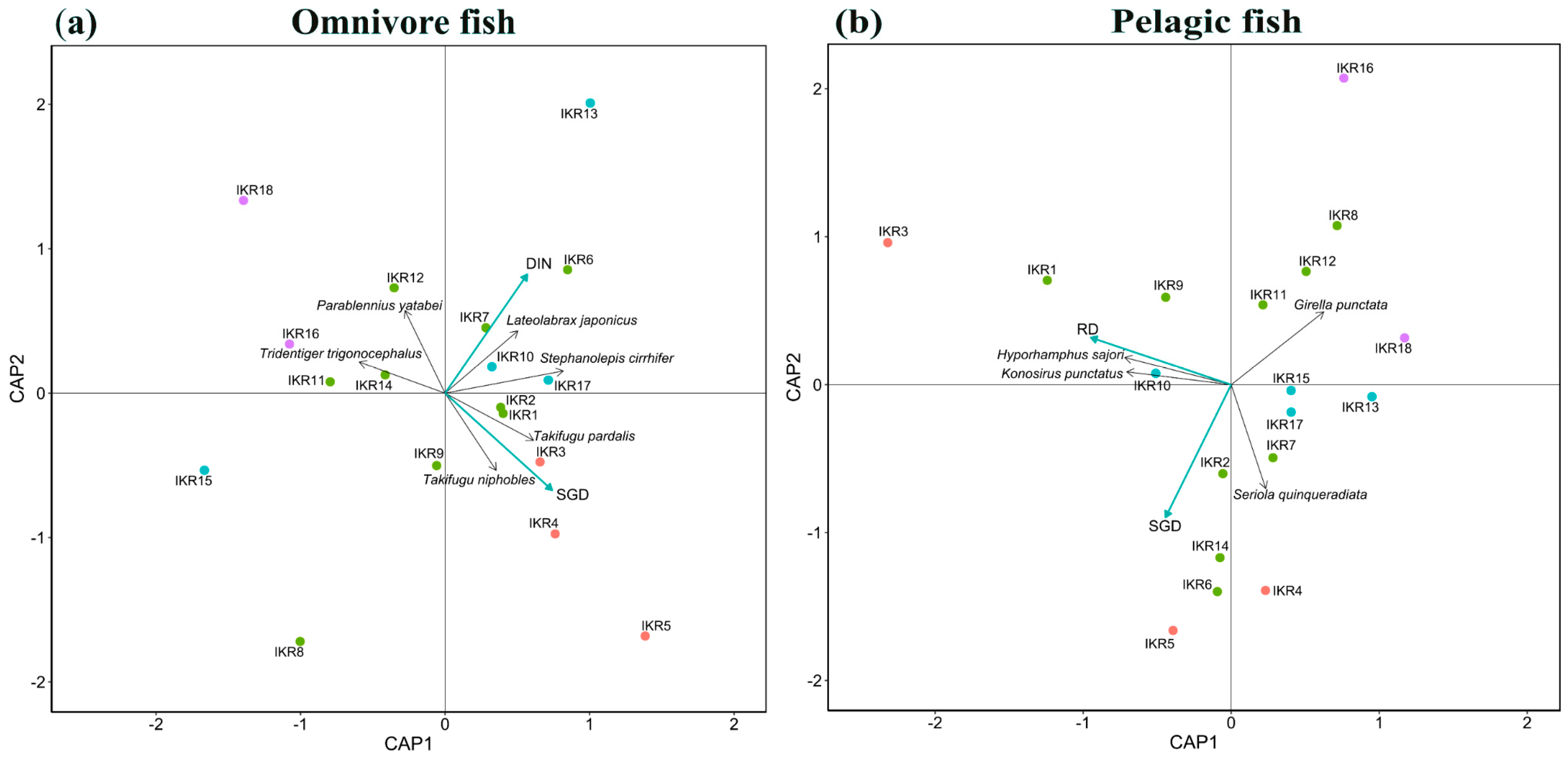
| Table | Category | Definition | Rationale |
|---|---|---|---|
| Feeding diets | Carnivores | Feeding mainly on smaller fish | Defined based on fish diet and aggregation of fish species that utilize the same food resource [39] |
| Herbivore | Feeding mainly on plant material | ||
| Omnivore | Feeding on food both of plant material and animal origins | ||
| Planktivore | Feeding mainly on plankton | ||
| Depth habits | Pelagic | Inhabit the upper water column | Reflects the degree of dependence of fish on their position in the water column [40] |
| Demersal | Live near the bottom |
| Model | Variable (Intercept) | Salinity | SGD | RD | df | AIC |
|---|---|---|---|---|---|---|
| Carnivore richness | 13.76 *** | −0.34 * | −7.5 | 3 | 85.4 | |
| Omnivore richness | 1.62 *** | 0.05 * | 2 | 75.2 | ||
| Planktivore richness | −20.55 | 0.64 * | 0.05 | 76.2 |
Disclaimer/Publisher’s Note: The statements, opinions and data contained in all publications are solely those of the individual author(s) and contributor(s) and not of MDPI and/or the editor(s). MDPI and/or the editor(s) disclaim responsibility for any injury to people or property resulting from any ideas, methods, instructions or products referred to in the content. |
© 2024 by the authors. Licensee MDPI, Basel, Switzerland. This article is an open access article distributed under the terms and conditions of the Creative Commons Attribution (CC BY) license (https://creativecommons.org/licenses/by/4.0/).
Share and Cite
Nhat, N.H.; Saito, M.; Onodera, S.-i.; Hamada, M.; Hyodo, F.; Nagare, H. Environmental DNA Reveals the Impact of Submarine Groundwater Discharge on the Spatial Variability of Coastal Fish Diversity. Biology 2024, 13, 609. https://doi.org/10.3390/biology13080609
Nhat NH, Saito M, Onodera S-i, Hamada M, Hyodo F, Nagare H. Environmental DNA Reveals the Impact of Submarine Groundwater Discharge on the Spatial Variability of Coastal Fish Diversity. Biology. 2024; 13(8):609. https://doi.org/10.3390/biology13080609
Chicago/Turabian StyleNhat, Nguyen Hong, Mitsuyo Saito, Shin-ichi Onodera, Mayuko Hamada, Fujio Hyodo, and Hideaki Nagare. 2024. "Environmental DNA Reveals the Impact of Submarine Groundwater Discharge on the Spatial Variability of Coastal Fish Diversity" Biology 13, no. 8: 609. https://doi.org/10.3390/biology13080609
APA StyleNhat, N. H., Saito, M., Onodera, S.-i., Hamada, M., Hyodo, F., & Nagare, H. (2024). Environmental DNA Reveals the Impact of Submarine Groundwater Discharge on the Spatial Variability of Coastal Fish Diversity. Biology, 13(8), 609. https://doi.org/10.3390/biology13080609






